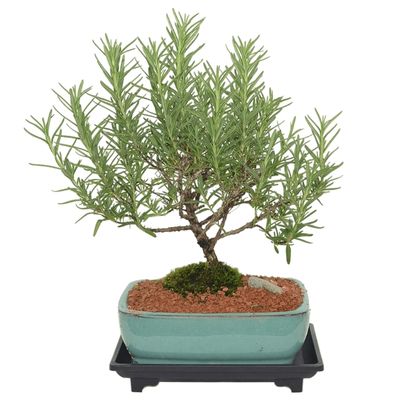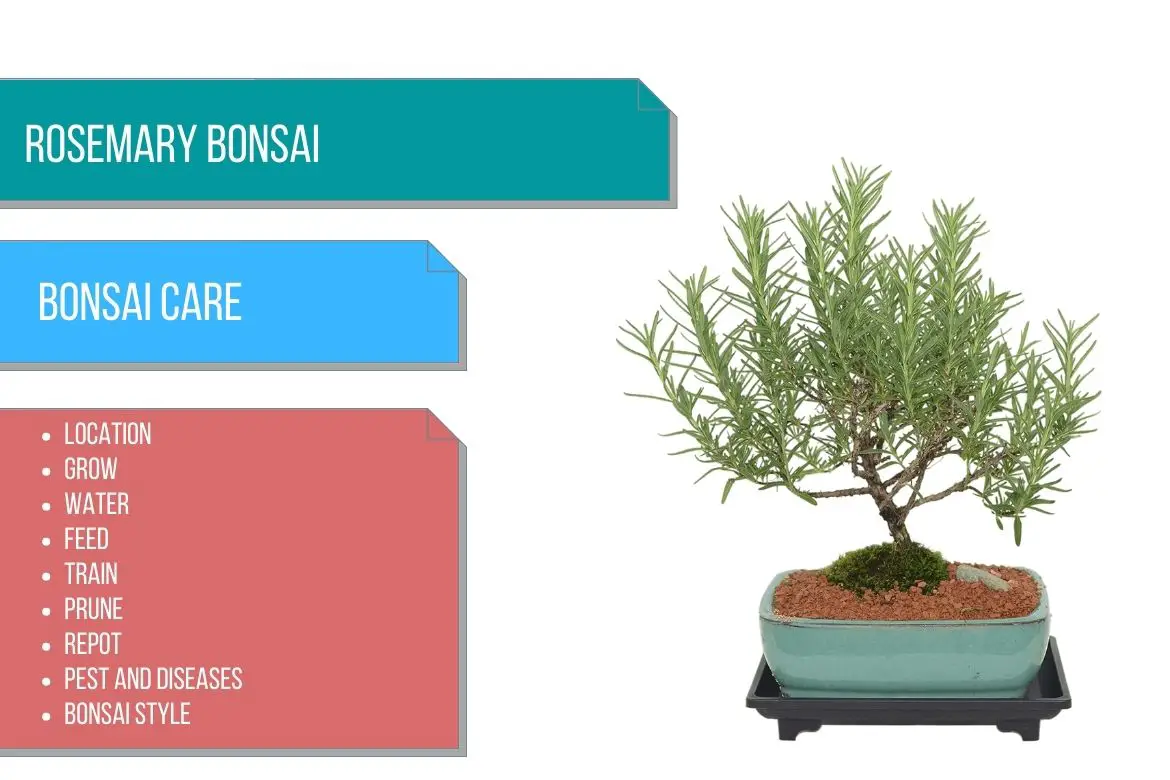
Rosemary
(Rosmarinus officinalis)
Country of Origin : Mediterranean
Bonsai Styles : Broom
Zone : 7 – 10
Rosemary is an evergreen, vigorously and compactly growing aromatic herb. This tree produces narrow needle-like foliage that is green in color, a woody trunk, and small spring flowers that are whitish-blue or mauve.
The leaves are aromatic, somewhat leathery, and bluish-green in color on the top surface and silvery on the hairy underside.
Rosemary bonsai tree has a wide array of features which makes it one of the most preferred bonsai trees. It has something for all kinds of bonsai enthusiasts.
Rosemary trees develop rough-fissured grey colored bark which gives the trunk an ancient look. This effect is enhanced even more when the tree partially sheds its fibrous bark. Hence, making this tree a top choice for people who love a bonsai with an interesting bark and trunk appearance.
Bonsai rosemary is also a great choice for people who are looking for a flowering bonsai tree. The tree blooms profusely from spring to summer with tiny blue flowers. (Hence, the flowering rosemary bonsai is also sometimes called “blue rosemary bonsai“).
A bonsai rosemary plant is also a suitable option for people looking for an aromatic bonsai tree.
Furthermore, adding to all the advantages of this bonsai, this thee can also be treated as an indoor bonsai tree.
As for rosemary bonsai styles, this tree is suitable for all types and sizes of bonsai styles. However, the broom style is the most common. In the broom style, only careful pruning and no wiring are required.
Read more about other bonsai trees species in : Bonsai tree care

In its natural habitat, the rosemary tree blooms almost throughout the year. However, spring through summer is a the time when the tree profusely produces flowers.

Rosemary bonsai in bloom.
Best location to keep Rosemary Bonsai
Bonsai rosemary prefers to be in a sunny location with low humidity.
When keeping the bonsai indoors, keep the bonsai container in a west or south facing window.
A suitable temperature range for the tree is between 70°F to 80°F (21°C – 26°C) in spring and summer and between 60°F to 65°F (15°C – 18°C) in winter.
In the summertime and after the last frost has passed, it can also be placed outside.
During the winter, it can be stored in an unheated room with a moderate level of humidity.
Rosemary is fairly tolerant of windy conditions. However, keep the tree away from cold winds.
The tree will not tolerate temperatures below 41°F (5°C).
IMP: Refer sunlight requirements for indoor plants for more indoor gardening ideas. Also, refer to do bonsai trees need sunlight for more indoor and outdoor bonsai location ideas.
Propagation of Rosemary
Rosemary can be propagated by softwood cutting in the summer.
Put the cuttings (5 to 6-inches) in a jar of water. Keep the jar in a bright, warm place. Sufficient rooting on the stem should occur in 1-2 months.
Propagating rosemary with seeds is not advisable as the seeds have a low germination rate. Furthermore they take a long time to germinate and grow.
One more advantage of using cuttings for propagation is that the plant will be a true copy of the parent plant.
Watering Rosemary Bonsai
Do you water rosemary bonsai every day ?
It is not a good idea to keep rosemary’s roots constantly moist. The soil should be watered only as needed, allowing it to dry out between watering.
Many parts of the root mass will die off if the soil is too damp.
You should water more when the plant is growing at its peak in the summer’s heat. However, make sure it really needs it before you pull out the watering can.
You can also use tap water to water your bonsai rosemary plant.
During the winter, keep the soil dry, but don’t let it completely dry out.
Read watering bonsai tree for more details.
Wiring Rosemary Bonsai
Since rosemary branches are somewhat stiff, they must be wired in order to be shaped.
You will need to use wire in order to establish basic branch positions and curvatures, then use clip-and-grow directional pruning in order to further shape the branches.
A thumb rule you can follow is, only try and wire branches that have a diameter of less than a pencil. Otherwise you run the risk of breaking mature brittle branches.
Branches up to two years old should be wired while still flexible.
Older branches should be guyed down to prevent bark damage.
Pruning Rosemary Bonsai
When to prune Rosemary bonsai?
How to prune Rosemary bonsai?
In spite of the fact that it is a vigorous grower, common rosemary slows down considerably in winter but does not cease to grow.
It is possible to perform rosemary bonsai pruning at any time of the year. Early spring is the advisable time.
If you are in the developing phase of bonsai rosemary tree, let the branches grow long, then prune them back to the desired length when they are mature.
It is possible to form beautiful cushion shapes by repeatedly reducing the shoots of the branches.
On the other hand, when a bonsai tree is mature, pruning a rosemary bonsai is needed to maintain the profile of the bonsai’s shape and to create a denser branching structure.
Rosemary develops new growth readily and abundantly from buds positioned further back on the branch.
In conjunction with the clip-and-grow method, this characteristic will help you develop branches with good movement and taper.
It is also possible to simply let weaker branches grow until they become stronger by themselves.
Repotting Rosemary Bonsai
When to repot Rosemary bonsai?
Bonsai rosemary can be repoted every 2 to 3 years in spring, before new growth sets in.
Root pruning does not pose a problem for rosemary’s roots since they grow very fast.
While repotting, remove some branches to maintain a balance between top growth and root growth.
You can use a basic free-draining bonsai soil mix as a potting soil.
OR
You can use a mix of sand, loam and peat moss in the ratio 2:1:1.
OR
You can also use a mix of garden compost, sand and fired clay particles in the ratio 1:1:1.
Must Read: Bonsai Soil Recipes
Must read : Choosing the right bonsai container
Feeding Rosemary Bonsai
During spring and summer, fertilize weekly with a balanced fertilizer at half strength.
The fertilization frequency can be set between two and three times per week in the fall and winter.
There will still be growth in winter even though it slows down a little, and a little fertilizer will keep the bonsai tree in good health.
However, stop fertilizer application when the temperature falls below 61°F (16°C).
Read more about bonsai fertilizer and its application.
Diseases and pest of Rosemary Bonsai
Rosmarinus bonsai is not prone to being attacked by pests. However, in rare cases it can be affected by Aphids, Leafhoppers, Spider mites, Spittlebugs, Thrips, Whiteflies.
Spittlebugs can be identified by their saliva like foam they leave on the tree. These pests usually feed on the sap of the roots. When identified, wash the insects and the foamy residue with a gentle jet of water.
All of these pests can be controlled by application of insecticidal soap, neem oil or horticultural oil. These can even be removed manually by a jet of water.
Rosemary tree is also susceptible to Powdery mildew. White powdery residue occurs on the leaves of the plant. Though not fatal for the plant, this disease will make the tree weak. It is one of the most common issues with indoor rosemary bonsai.
It is possible to remove powdery mildew from your rosemary plant in part by gently rubbing the leaves of the plant. Leaving it untreated will cause your rosemary plant bonsai to drop its leaves.
Rosemary bonsai care
Provide ample amounts of light especially in the growing season. The tree will grow vigorously in such conditions.
The tree also needs high humidity and cold winters.
When trying to buy a rosemary plant for making a bonsai, choose a plant that has a slightly woody stem.
During the winter months, it is critical to be careful not to let the soil get too wet, or else the plant will lose its leaves and young shoots—and in some cases even the whole branch.
In the case of rosemary, if the bottom leaves of the plant turn yellow and its growth is slowing down, this is a sign that the plant needs to be fertilized or the roots of the tree are potbound.
A rosemary plant can become ruined by root rot disease if it is not treated in time. There are two most common causes of root rot in rosemary plants, and they are either over-watering or a fungal infection.

